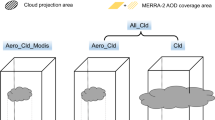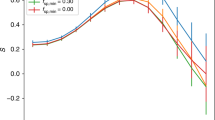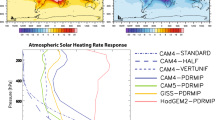Abstract
Aerosols from biomass burning can alter the radiative balance of the Earth by reflecting and absorbing solar radiation1. Whether aerosols exert a net cooling or a net warming effect will depend on the aerosol type and the albedo of the underlying surface2. Here, we use a satellite-based approach to quantify the direct, top-of-atmosphere radiative effect of aerosol layers advected over the partly cloudy boundary layer of the southeastern Atlantic Ocean during July–October of 2006 and 2007. We show that the warming effect of aerosols increases with underlying cloud coverage. This relationship is nearly linear, making it possible to define a critical cloud fraction at which the aerosols switch from exerting a net cooling to a net warming effect. For this region and time period, the critical cloud fraction is about 0.4, and is strongly sensitive to the amount of solar radiation the aerosols absorb and the albedo of the underlying clouds. We estimate that the regional-mean warming effect of aerosols is three times higher when large-scale spatial covariation between cloud cover and aerosols is taken into account. These results demonstrate the importance of cloud prediction for the accurate quantification of aerosol direct effects.
This is a preview of subscription content, access via your institution
Access options
Subscribe to this journal
Receive 12 print issues and online access
$259.00 per year
only $21.58 per issue
Buy this article
- Purchase on Springer Link
- Instant access to full article PDF
Prices may be subject to local taxes which are calculated during checkout



Similar content being viewed by others
References
Intergovernmental Panel of Climate Change (IPCC). The Physical Science Basis, Contribution of Working Group I to the Fourth Assessment Report of the IPCC 916 (Cambridge Univ. Press, 2007).
Keil, A. & Haywood, J. M. Solar radiative forcing by biomass burning aerosol particles during SAFARI 2000: A case study based on measured aerosol and cloud properties. J. Geophys. Res. 108, 8467 (2003).
Schulz, M. et al. Radiative forcing by aerosols as derived from the AeroCom present-day and pre-industrial simulations. Atmos. Chem. Phys. 6, 5225–5246 (2006).
Ramanathan, V. & Carmichael, G. Global and regional climate changes due to black carbon. Nature Geosci. 1, 221–227 (2008).
Bellouin, N., Jones, A., Haywood, J. & Christopher, S. A. Updated estimate of aerosol direct radiative forcing from satellite observations and comparison against the Hadley Centre climate model. J. Geophys. Res. 113, D10205 (2008).
Haywood, J. & Boucher, O. Estimates of the direct and indirect radiative forcing due to tropospheric aerosols: A review. Rev. Geophys. 38, 513–543 (2000).
Chýlek, P. & Coakley, J. A. Jr. Aerosol and climate. Science 183, 75–77 (1974).
Seinfeld, J. Black carbon and brown clouds. Nature Geosci. 1, 15–16 (2008).
Satheesh, S. K. & Ramanathan, V. Large differences in tropical aerosol forcing at the top of the atmosphere and Earth’s surface. Nature 405, 60–63 (2000).
Podgorny, I. A. & Ramanathan, V. A modeling study of the direct effect of aerosols over the tropical Indian Ocean. J. Geophys. Res. 106, 24097–24105 (2001).
Fishman, J., Hoell, J. M., Bendura, R. D., McNeal, R. J. & Kirchhoff, V. W. J. H. NASA GTE TRACE-A experiment (September–October, 1992). J. Geophys. Res. 101, 23865–23879 (1996).
Kaufman, Y. J. et al. Smoke, clouds and radiation-Brazil (SCAR-B) experiment. J. Geophys. Res. 103, 31783–31808 (1998).
Andreae, M. O. et al. Biomass-burning emissions and associated haze layers over Amazonia. J. Geophys. Res. 93, 1509–1527 (1988).
Andreae, M. O. et al. Influence of plumes from biomass burning on atmospheric chemistry over the equatorial Atlantic during CITE-3. J. Geophys. Res. 99, 12793–12808 (1994).
Lindesay, J. A. et al. International geosphere biosphere programme/international global atmospheric chemistry SAFARI-92 field experiment: Background and overview. J. Geophys. Res. 101, 23521–23530 (1996).
Holben, B. N. et al. AERONET: A federated instrument network and data archive for aerosol characterization. Remote Sens. Environ. 66, 1–16 (1998).
King, M. D., Kaufman, Y. J., Menzel, W. P. & Tanre, D. Remote sensing of cloud, aerosol, and water vapor properties from the moderate resolution imaging spectrometer (MODIS). IEEE Trans. Geosci. Remote Sens. 30, 2–27 (1992).
Remer, L. A. et al. The MODIS aerosol algorithm, products, and validation. J. Atmos. Sci. 62, 947–973 (2005).
Myhre, L. et al. Regional aerosol optical properties and radiative impact of the extreme smoke event in the European Arctic in spring 2006. Atmos. Chem. Phys. 7, 5899–5915 (2007).
Kaufman, Y. J., Remer, L. A. & Tanre, D. A critical examination of the residual cloud contamination and diurnal sampling effects on MODIS estimates of aerosol over ocean. IEEE Trans. Geosci. Remote Sens. 43, 2886–2897 (2005).
Chand, D. et al. Quantifying above-cloud aerosol using spaceborne lidar for improved understanding of cloudy-sky direct climate forcing. J. Geophys. Res. 113, D13206 (2008).
Mishchenko, M. I. et al. Accurate monitoring of terrestrial aerosols and total solar irradiance: Introducing the glory mission. Bull. Am. Meteorol. Soc. 88, 677–691 (2007).
Leahy, L. V., Anderson, T. L., Eck, T. F. & Bergstrom, R. W. A synthesis of single scattering albedo of biomass burning aerosol over southern Africa during SAFARI 2000. Geophys. Res. Lett. 34, L12814 (2007).
Haywood, J. M. et al. The mean physical and optical properties of regional haze dominated by biomass burning aerosol measured from the C-130 aircraft during SAFARI 2000. J. Geophys. Res. 108, 8473 (2003).
Chand, D. et al. Optical and physical properties of aerosols in the boundary layer and free troposphere over the Amazon Basin during the biomass burning season. Atmos. Chem. Phys. 6, 2911–2925 (2006).
Anderson, T. L. et al. An ‘A-Train’ strategy for quantifying direct climate forcing by anthropogenic aerosols. Bull. Am. Meteorol. Soc. 86, 1795–1809 (2005).
Karlsson, J., Svensson, G. & Rodhe, H. Cloud radiative forcing of subtropical low level clouds in global models. Clim. Dyn. 30, 779–788 (2008).
Loeb, N. G. & Schuster, G. L. An observational study of the relationship between cloud, aerosol and meteorology in broken low-level cloud conditions. J. Geophys. Res. 113, 10.1029/2007JD009763 (2008).
King, M. D., Tsay, S. C., Platnick, S. E., Wang, M. & Liou, K. N. Cloud Retrieval Algorithms for MODIS: Optical Thickness, Effective Particle Radius, and Thermodynamic Phase. MODIS Algorithm Theoretical Basis Doc. ATBD-MOD-05 (NASA, 1997).
Coakley, J. A. & Chýlek, P. The two-stream approximation in radiative transfer: Including the angle of the incident radiation. J. Atmos. Sci. 32, 409 (1975).
Ricchiazzi, P., Yang, S., Gautier, C. & Sowle, D. SBDART: A research and teaching tool for plane-parallel radiative transfer in the Earth’s atmosphere. Bull. Am. Meteorol. Soc. 79, 2101–2114 (1998).
Acknowledgements
This work was supported by University of Washington startup funds, NASA’s CALIPSO Mission (contract NAS1-99105), National Science Foundation (grants ATM-0601177 and ATM-0205198) and the National Oceanographic and Atmospheric Administration (grant NA070AR4310282). S.K.S. would like to thank NPP administered by Oak Ridge Associated Universities (ORAU) for an NPP fellowship.
Author information
Authors and Affiliations
Contributions
D.C. carried out the bulk of the analysis of CALIPSO data using a retrieval algorithm designed by D.C., T.L.A., R.W. and R.J.C. (plus colleagues at NASA Langley). MODIS cloud data were synthesized by R.W., D.C. and S.K.S. carried out the RTM analysis. D.C. wrote the bulk of the manuscript, with major input from R.W. and T.L.A. R.W. and T.L.A. provided project oversight.
Corresponding author
Ethics declarations
Competing interests
The authors declare no competing financial interests.
Supplementary information
Supplementary Fig. S1
Supplementary Information (PDF 277 kb)
Rights and permissions
About this article
Cite this article
Chand, D., Wood, R., Anderson, T. et al. Satellite-derived direct radiative effect of aerosols dependent on cloud cover. Nature Geosci 2, 181–184 (2009). https://doi.org/10.1038/ngeo437
Received:
Accepted:
Published:
Issue Date:
DOI: https://doi.org/10.1038/ngeo437
This article is cited by
-
Chemometric approach to evaluate the chemical behavior of rainwater at high altitude in Shaune Garang catchment, Western Himalaya
Scientific Reports (2022)
-
Scattering and absorbing aerosols in the climate system
Nature Reviews Earth & Environment (2022)
-
Particulate Matter (PM2.5) Characterization, Air Quality Level and Origin of Air Masses in an Urban Background in Pretoria
Archives of Environmental Contamination and Toxicology (2022)
-
Aerosol-boundary-layer-monsoon interactions amplify semi-direct effect of biomass smoke on low cloud formation in Southeast Asia
Nature Communications (2021)
-
Suppression of aerosol-induced atmospheric warming by clouds in the Indo-Gangetic Basin, northern India
Theoretical and Applied Climatology (2019)



